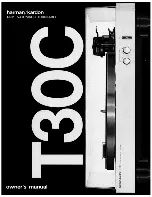
Page 3
cylinder, and hereafter the piston must not be pulled up again, as the silicone fluid would then
easily stick to the walls of the lift cylinder. If this happens the piston will "go down" much too
slow.
The tonearm is supplied with damping for the horizontal movement. Damping the vertical
movement is not always an advantage. If desired, silicone fluid is filled into the well of the
tonearm base. This is done through the hole, which is seen in the plexiglass on top of the arm
base, when the arm tube is not on. Resting like this the tip of the syringe can just reach the
well through this hole. Inject 0.2 ml (20 units) of the silicone fluid into the well, and carefully
"wipe off" the tip of the syringe on the edge of the well, before pulling the syringe up with a
little jerk. The plexiglass over the well must not be unscrewed.
The damping of the vertical movement of the tonearm is obtained with the screw, to which the
arm tube is attached.
It goes all the way down into the silicone fluid. When the tonearm is supplied this screw is in
its lower position, and if silicone fluid is injected, it will give maximum damping. The damping
is reduced as the said screw is turned some revolutions up with the hexagon spanner. For
further adjustment it should be noted, that the screw should not be forced down into the bot-
tom of the well. This will make the tonearm rock in its bearings. Be careful if you want to
increase damping again. The screw must be at least one revolution above the bottom of the
well. (If measured the screw must protude minimum 11.5 - 12 mm (about 15/32”) above the
surface of the plexiglass).
•
Mounting the cartridge
Using the accompanying finger lever the cartridge now can be mounted on the arm tube. If
possible, use the accompanying aluminium screws. Provided that the tonearm is mounted, so
that the distance from the pivot to the centre of the turntable is as indicated on the mounting
template, the position of the stylus - to obtain correct overhang - should be: with standard arm
tubes right under the front edge of the black plane of the arm tube - with PRECISION arm
tubes 4 mm (5/32”) behind the front edge. Also the cartridge should be in parallel to the said
black plane. Carefully push the terminal jacks of the wires unto the pins of the cartridge with a
pair of tweezers. Do not squeeze the thin wiring too hard. Red and green are signal and
ground of right channel. White and blue are signal and ground of left channel. Then fasten the
arm tube on the arm base with the accompanying knurled not, which should be tightened well
with two fingers. Check that the overhang is correct - 18 mm (23/32”) - and adjust if
necessary.
•
Adjusting the tone arm
First make a coarse adjustment of the weights. The tracking force weight - and where marked
2) also the small counterweight - should be back at the end of the counterweight rod, while
moving the counterweight/s backwards or forwards until the arm tube is balancing in about
horizontal position.
Apply tracking force by sliding the tracking force weight and may be also the small
counterweight forwards. Both of these weights will give ½ gram for each indentation that they
are moved forwards. Thus together they will give 1 gram.
If one of the counterweights is going to be used to apply tracking force, the tonearm should be
balanced with the weights arranged in such a way that there is room enough to move the
counterweight in question.
It is an advantage to use as large or as many counterweights as possible.
And by coarse adjustment of the weights it appears that the counterweight can not get far
enough forwards to obtain balance, the tracking force weight can be slid forwards until
balance is obtained. This place then will be zero point for the tracking force calibration. If the
Summary of Contents for DP-6
Page 1: ......























